Hydrocarbon Geological Characteristics and Factors Controlling Hydrocarbon Accumulation of Jurassic Da’anzhai Continental Shale
Abstract
:1. Introduction
2. Geological Setting
3. Sample and Methods
3.1. Sample Information
3.2. Experimental Methods
3.2.1. Total Organic Content Test (TOC) and Mineral Composition
3.2.2. Rock Pyrolysis (S1)
3.2.3. Argon Ion Polishing Scanning Electron Microscope (SEM)
3.2.4. Low-Pressure N2 Adsorption
3.2.5. NMR and Centrifuge Experiment
4. Results
4.1. Hydrocarbon Geological Characteristics
4.1.1. Lithological Association and Mineral Composition
4.1.2. Reservoir Space and Physical Characteristics
4.1.3. Organic Geochemical Features
4.1.4. Oil-Bearing Property
4.2. Mobility Characteristics of Shale Oil
4.2.1. Pore Structure in J1dn Continental Shale
4.2.2. Movable Oil Content in J1dn Continental Shale
5. Discussion
5.1. Favorable Combination Types
5.2. Favorable Exploration Direction
6. Conclusions
- (1)
- The Jurassic Da’anzhai lacustrine shale oil reservoir was divided vertically into three sub-members. Organic-rich continental shales developed within the second sub-member. Three types of lithological association developed in the organic-rich shale interval. Generally, the brittleness index of the organic-rich Da’anzhai lacustrine shale was relatively low. The porosity of the J1dn continental shale varied from 0.5% to 10.5% (average value of 5.89%). The pores were predominantly composed of inorganic pores, with a small proportion of organic pores. The average porosity of the shell limestone was only 1.2%, but fractures at the micron and centimeter scales were well developed.
- (2)
- The OM types of the J1dn continental shale were II1–II2, with a small amount of Type 1. The maturity of the OM was observed in the oil generation stage. The average oil saturation of the J1dn continental shale was 3.15%, with most samples having oil saturation of less than 4%. The average free hydrocarbon (S1) value was 1.34 mg/g, the average hydrocarbon generation potential (S1 + S2) was 5.9 mg/g, and the OSI content was 99.22 mg/g. The J1dn continental shale has high shale oil exploration potential. Type 1 shale oil is affected by multiscale fractures, including bedding fractures, and has the best mobility. The high hydrocarbon generation quality of continental shale, coupled with the multiscale fractures within the shell limestone and continental shale, is the principal factor controlling shale oil enrichment.
- (3)
- Based on the differences in the macroscopic parameters of shale reservoirs under different lithological association conditions, the Type 1 shale association was selected as the most favorable lithological association type. Type 1 shale has the best shale oil enrichment conditions, providing an exploration target for the development of Jurassic Da’anzhai shale oil in the Sichuan Basin. Further analysis of the differences in micro-enrichment patterns and controlling factors of shale oil under different lithological associations is required.
Author Contributions
Funding
Data Availability Statement
Acknowledgments
Conflicts of Interest
References
- Ma, Y.; Cai, X.; Zhao, P.; Hu, Z.; Liu, H.; Gao, B.; Wang, W.; Li, Z.; Zhang, Z. Geological characteristics and exploration practices of continental shale oil in China. Acta Geol. Sin. 2022, 96, 155–171. [Google Scholar] [CrossRef]
- Song, M.; Liu, H.; Wang, Y.; Liu, Y. Enrichment rulesand exploration practices of Paleogene shale oil in Jiyang Depression, Bohai Bay Basin, China. Pet. Explor. Dev. 2020, 47, 225–235. [Google Scholar] [CrossRef]
- Yu, Y.J.; Wang, H.Y.; Liu, D.X.; Zhao, Q.; Li, X.B.; Wu, J.; Xia, Z.Y. Development Status and Feasibility Evaluation Index System of Continental Shale Oil Demonstration Area in China. Earth Sci. 2023, 48, 191–205. [Google Scholar] [CrossRef]
- Wang, E.; Guo, T.; Li, M.; Xiong, L.; Dong, X.; Wang, T.; Ouyang, J. Reservoir characteristics and oil properties of a lacustrine shale system: Early Jurassic black shale from the Sichuan Basin, SW China. J. Asian Earth Sci. 2023, 242, 1367–9120. [Google Scholar] [CrossRef]
- Bai, X.; Huang, S.; Wang, X.; Wang, Z.; Wang, Y.; Ma, W.; Zhu, Y.; Sun, M.; Liu, B.; Fu, X.; et al. Microscopic Analysis of Natural Fracture Properties in Organic-Rich Continental Shale Oil Reservoirs: A Case Study from the Lower Jurassic in the Sichuan Basin, China. J. Mar. Sci. Eng. 2023, 11, 1036. [Google Scholar] [CrossRef]
- Wang, E.; Feng, Y.; Guo, T.; Li, M.; Xiong, L.; Lash, G.G.; Dong, X.; Wang, T.; Ouyang, J. Sedimentary differentiation triggered by the Toarcian Oceanic Anoxic Event and formation of lacustrine shale oil reservoirs: Organic matter accumulation and pore system evolution of the Early Jurassic sedimentary succession, Sichuan Basin, China. J. Asian Earth Sci. 2023, 256, 105825. [Google Scholar] [CrossRef]
- Zou, C.; Yang, Z.; Wang, H.; Dong, D.; Liu, H.; Shi, Z.; Zhang, B.; Sun, S.; Liu, D.; Li, G.; et al. “Exploring petroleum inside source kitchen”: Jurassic unconventional continental giant shale oil & gas field in Sichuan basin, China. Acta Geol. Sin. 2019, 93, 1551–1562. [Google Scholar] [CrossRef]
- Cheng, D.; Zhang, Z.; Hong, H.; Zhang, S.; Qin, C.; Yuan, X.; Zhang, B.; Zhou, C.; Deng, Q. Sequence structure, sedimentary evolution and their controlling factors of the Jurassic Lianggaoshan Formation in the East Sichuan Basin, SW China. Pet. Explor. Dev. 2023, 50, 293–305. [Google Scholar] [CrossRef]
- Liu, H.; Li, B.; Wang, Y.; Tian, J.; Sun, Y. Reservoir Characteristics of the Tight Oil Reservoir of the Da’anzhai Member in Central Sichuan Basin, SW China. J. Southwest Pet. Univ. 2018, 40, 47–55. [Google Scholar] [CrossRef]
- Jiang, L.; Zhao, W.; Zhang, B.; Zheng, C.; Hong, F.; Hao, J. Characterization Method of Tight Sandstone Reservoir Heterogeneity and Tight Gas Accumulation Mechanism, Jurassic Formation, Sichuan Basin, China. Geofluids 2022, 2022, 9420835. [Google Scholar] [CrossRef]
- Wang, E.; Li, Y.; Guo, T.; Xiong, L.; Dong, X.; Wang, T.; Shi, K. Geological Features, Paleosedimentary Environment, and Organic Matter Accumulation Mechanisms of the Lacustrine Shale Oil System: A Case Study of the Jurassic Dongyuemiao Member in the Sichuan Basin. Processes 2023, 11, 2638. [Google Scholar] [CrossRef]
- Hu, D.; Wei, Z.; Liu, R.; Wei, X.; Chen, F.; Liu, Z. Enrichment control factors and exploration potential of lacustrine shale oil and gas: A case study of Jurassic in the Fuling area of the Sichuan Basin. Nat. Gas Ind. B 2022, 9, 1–8. [Google Scholar] [CrossRef]
- Yuan, X.; Zhang, K.; Peng, J.; Li, B.; Han, F.; Chen, X.; Zheng, Z.; Ruan, J.; Ye, L.; Wang, Z.; et al. Study on characteristics of oil and gas occurrence and reservoir space of medium-high maturity continental shale—A case study of middle jurassic lianggaoshan formation in fuling block, southeast of sichuan basin, south China. Front. Earth Sci. 2022, 10, 1032018. [Google Scholar] [CrossRef]
- Lei, W.; Chen, D.; Liu, Z.; Cheng, M. Paleoenvironment-driven organic matter accumulation in lacustrine shale mixed with shell bioclasts:A case study from the Jurassic Da’anzhai member, Sichuan Basin (China). J. Pet. Sci. Eng. 2023, 220, 111178. [Google Scholar] [CrossRef]
- He, W.; He, H.; Wang, Y.; Cui, B.; Meng, Q.; Guo, X.; Bai, X.; Wang, Y. Major breakthrough and significance of shale oil of the Jurassic Lianggaoshan Formation in Well Ping’an 1 in northeastern Sichuan Basin. China Pet. Explor. 2022, 27, 40–49. [Google Scholar] [CrossRef]
- Cai, G.; Gu, Y.; Fu, Y.; Jiang, Y.; Wei, Z.; Wang, Z.; Liu, R.; Qiu, X. Pore system classification of Jurassic Da’anzhai Member lacustrine shale: Insight from pore fluid distribution. Energy Explor. Exploit. 2023, 41, 900–921. [Google Scholar] [CrossRef]
- Yang, Y.; Wen, L.; Wang, X.; Hong, H.; Zhu, H.; Xiong, Y.; Li, M.; Lu, J.; Zeng, D.; Yang, W. Geological characteristics and favorable exploration area selection of shale oil and gas of the Lower Jurassic Da’anzhai Member in the Sichuan Basin. Nat. Gas Ind. 2023, 43, 32–42. [Google Scholar]
- Liang, H.; Wen, L.; Ran, Q.; Han, S.; Liu, R.; Chen, K.; Di, G.; Chen, X.; Pei, Y. Structural characteristics and implications on oil/gas accumulation in north segment of the Longmenshan piedmont, northwestern Sichuan Basin, SW China. Pet. Explor. Dev. 2022, 49, 546–559. [Google Scholar] [CrossRef]
- Xiao, Z.; Chen, S.; Zhang, S.; Zhang, R.; Zhu, Z.; Lu, J.; Li, Y.; Yin, X.; Tang, L.; Liu, Z.; et al. Sedimentary environment and model for lacustrine organic matter enrichment: Lacustrine shale of the Early Jurassic Da’anzhai Formation, central Sichuan Basin, China. J. Palaeogeogr. 2021, 10, 584–601. [Google Scholar] [CrossRef]
- Li, H. Research progress on evaluation methods and factors influencing shale brittleness: A review. Energy Rep. 2022, 8, 4344–4358. [Google Scholar] [CrossRef]
- Li, J.; Li, H.; Yang, C.; Ren, X.; Li, Y. Geological characteristics of deep shale gas and their effects on shale fracability in the Wufeng-Longmaxi Formations of the southern Sichuan Basin, China. Lithosphere 2023, 1, 4936993. [Google Scholar] [CrossRef]
- Beti, D.; Jiang, C.; Panja, P.; Ring, T.; Levey, R. Hydrocarbon distributions of incremental S1 peaks corresponding to different boiling point ranges of petroleum in rock samples. J. Pet. Sci. Eng. 2020, 191, 107174. [Google Scholar] [CrossRef]
- Li, H.; Zhou, J.; Mou, X.; Guo, H.; Wang, X.; An, H.; Mo, Q.; Long, H.; Dang, C.; Wu, J.; et al. Pore structure and fractal characteristics of the marine shale of the Longmaxi Formation in the Changning Area, Southern Sichuan Basin, China. Front. Earth Sci. 2022, 10, 1018274. [Google Scholar] [CrossRef]
- Li, J.; Li, H.; Yang, C.; Wu, Y.; Gao, Z.; Jiang, S. Geological characteristics and controlling factors of deep shale gas enrichment of the Wufeng-Longmaxi Formation in the southern Sichuan Basin, China. Lithosphere 2022, S12, 4737801. [Google Scholar] [CrossRef]
- Thommes, M.; Kaneko, K.; Neimark, A.V.; Olivier, J.P.; Rodriguez-Reinoso, F.; Rouquerol, J.; Sing, K.S. Physisorption of gases, with special reference to the evaluation of surface area and pore size distribution (IUPAC Technical Report). Pure Appl. Chem. 2015, 87, 1051–1069. [Google Scholar] [CrossRef]
- Guo, Q.; Wang, J.; Chen, X.; Chen, N.; Wu, X.; Liu, Z. Discussion on evaluation method of total oil and movable oil in-place. Oil Gas Geol. 2021, 42, 1451–1463. [Google Scholar] [CrossRef]
- Li, J.; Huang, W.; Lu, S.; Wang, M.; Chen, G.; Tian, W.; Guo, Z. Nuclear magnetic resonance T1-T2 map division method for hydrogen-bearing components in continental shale. Energy Fuels 2018, 32, 9043–9054. [Google Scholar] [CrossRef]
- Li, J.; Jiang, C.; Wang, M.; Lu, S.; Chen, Z.; Chen, G.; Li, J.; Li, Z.; Lu, S. Adsorbed and free hydrocarbons in unconventional shale reservoir: A new insight from NMR T1-T2 maps. Mar. Pet. Geol. 2020, 116, 104311. [Google Scholar] [CrossRef]
- Medici, G.; Lorenzi, V.; Sbarbati, C.; Manetta, M.; Petitta, M. Structural classification, discharge statistics, and recession analysis from the springs of the Gran Sasso (Italy) carbonate aquifer; comparison with selected analogues worldwide. Sustainability 2023, 15, 10125. [Google Scholar] [CrossRef]
- Li, W.; Zhao, H.; Wu, H.; Wang, L.; Sun, W.; Ling, X. A novel approach of two-dimensional representation of rock fracture network characterization and connectivity analysis. J. Pet. Sci. Eng. 2020, 184, 106507. [Google Scholar] [CrossRef]
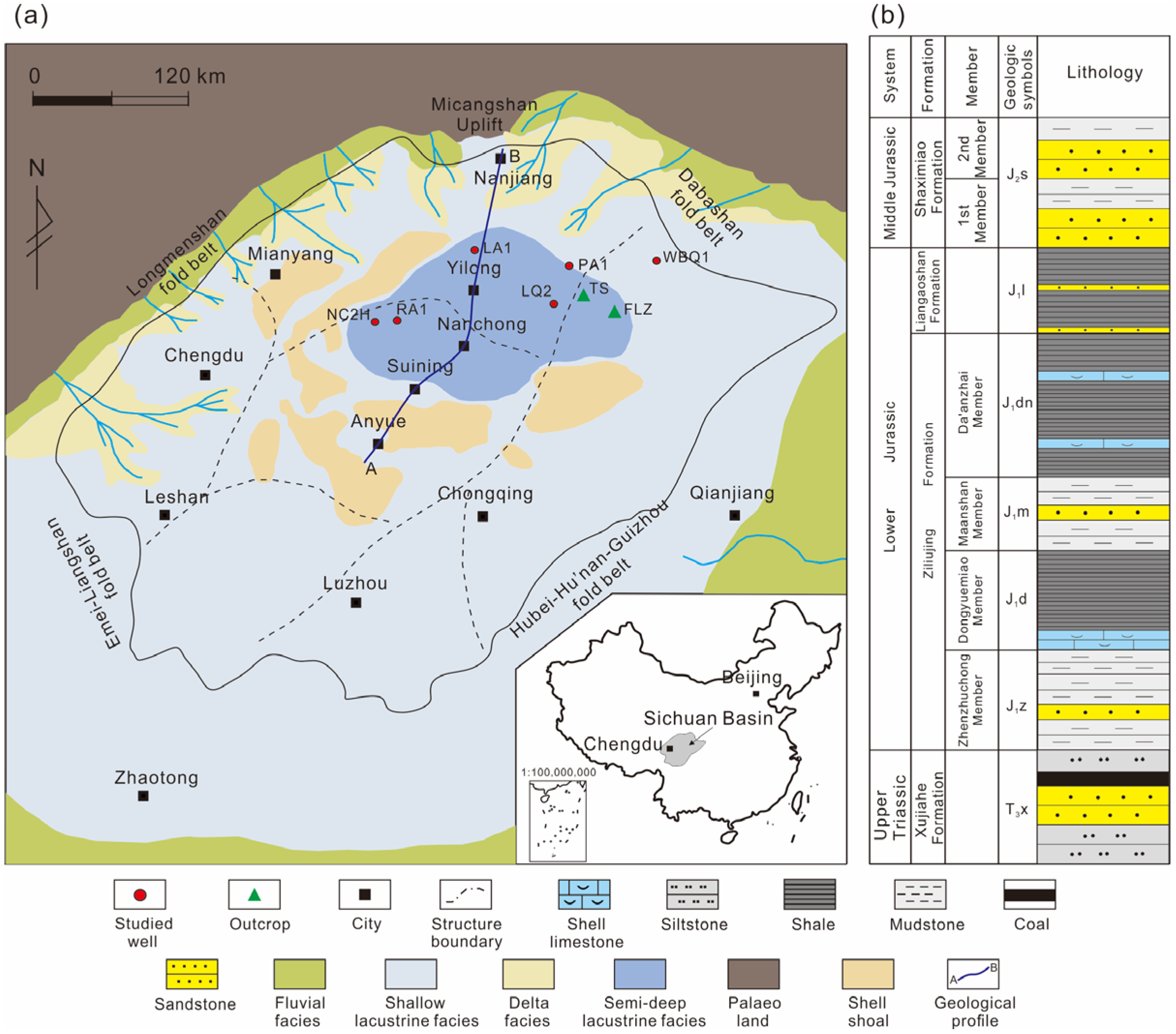

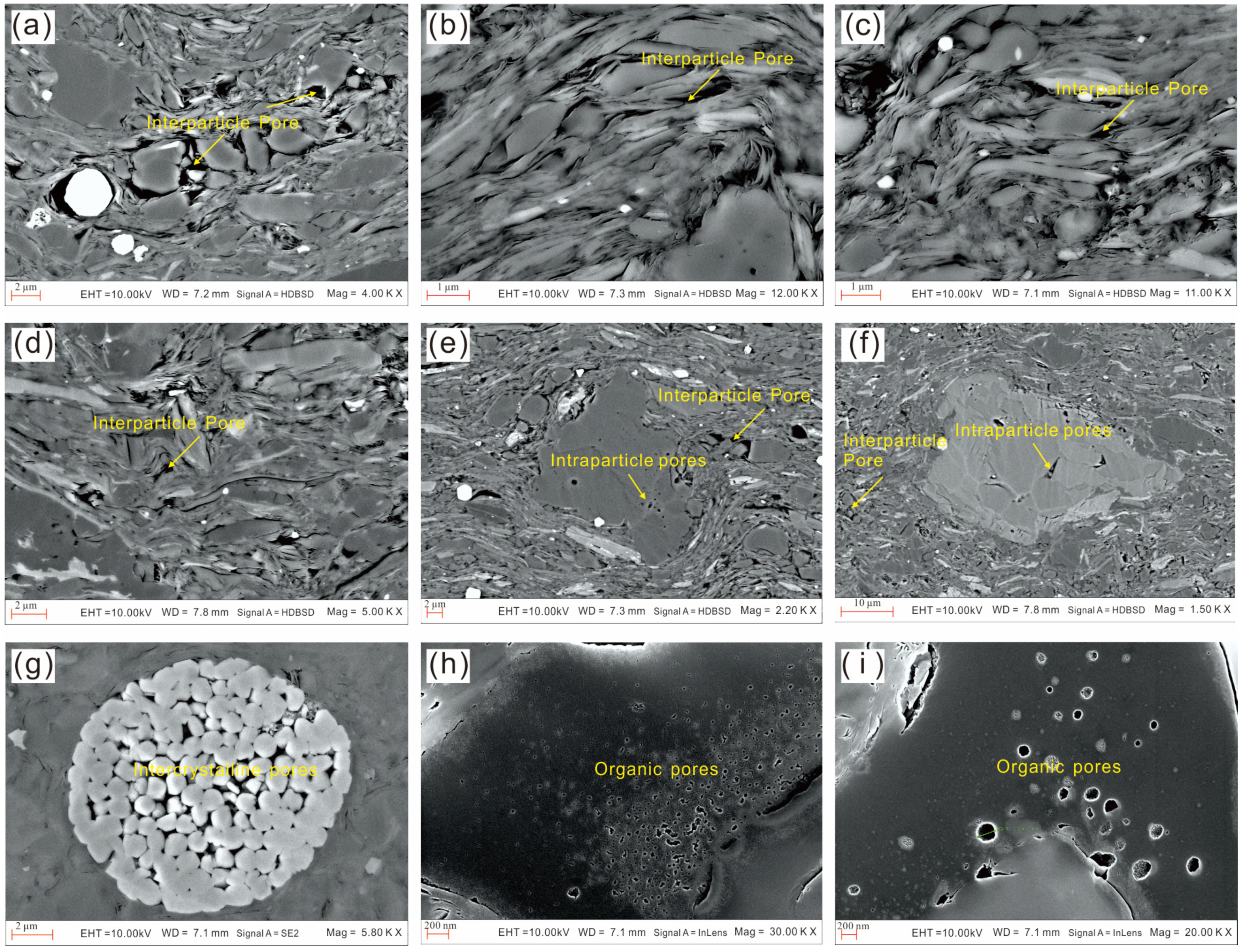
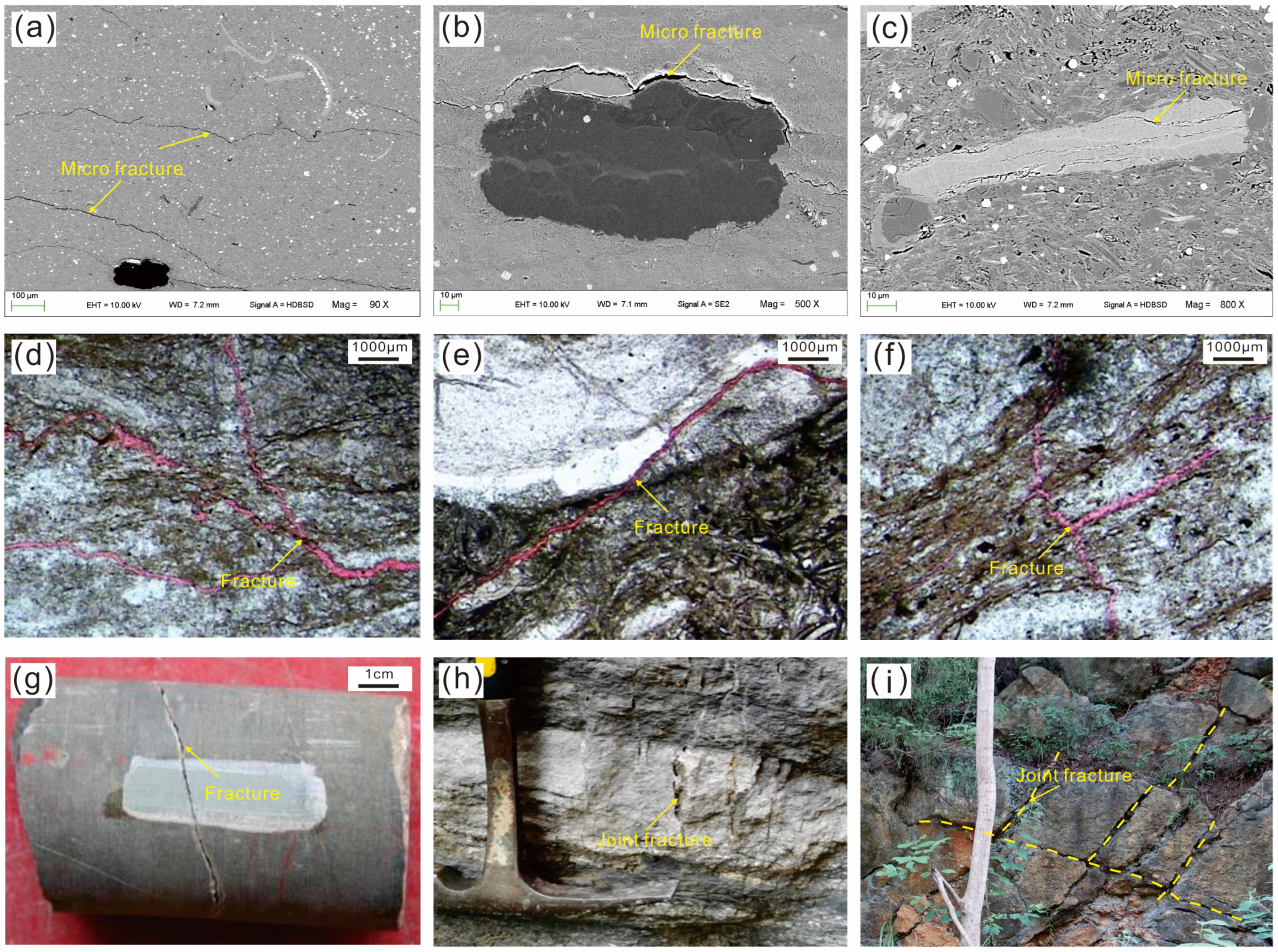
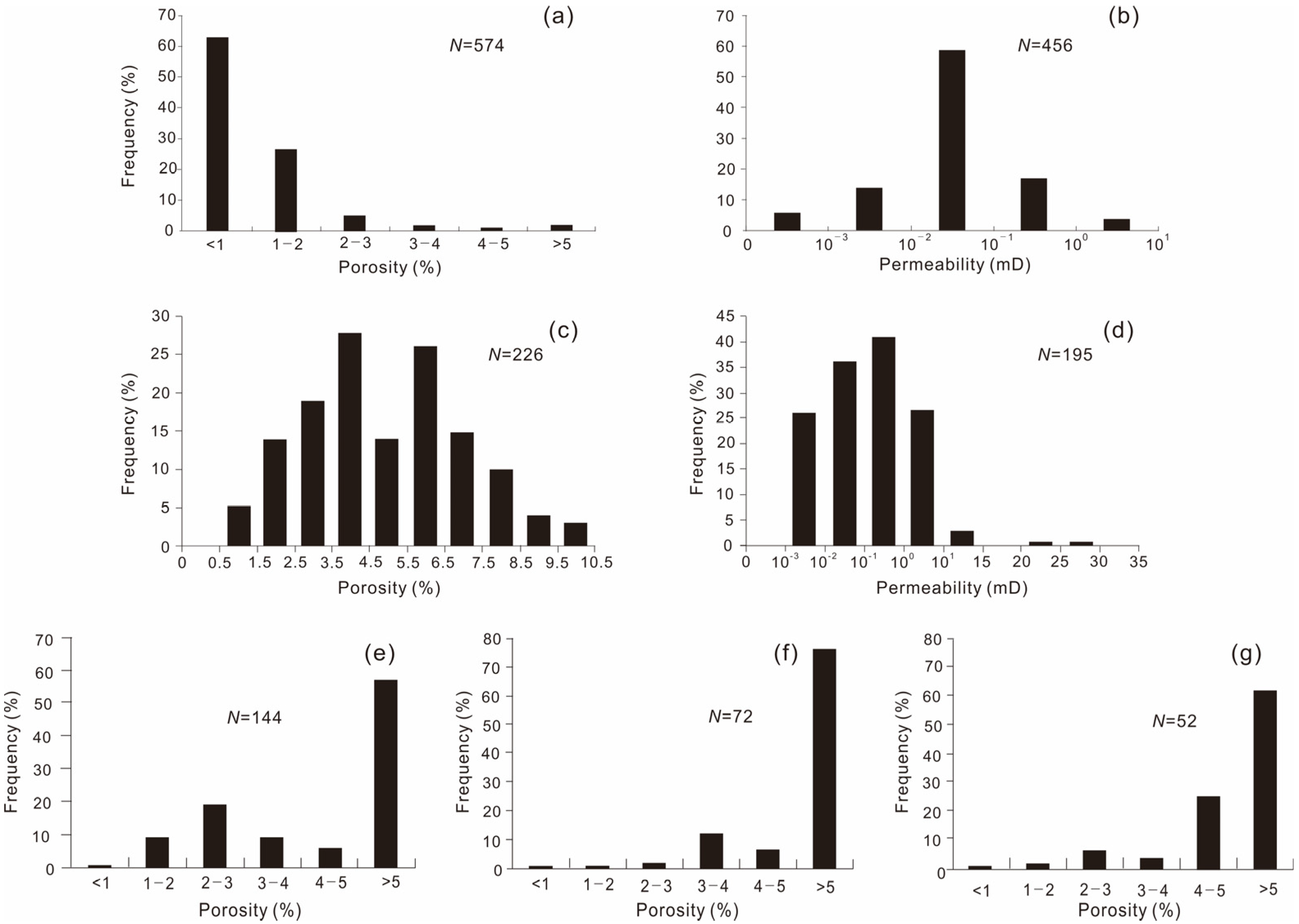
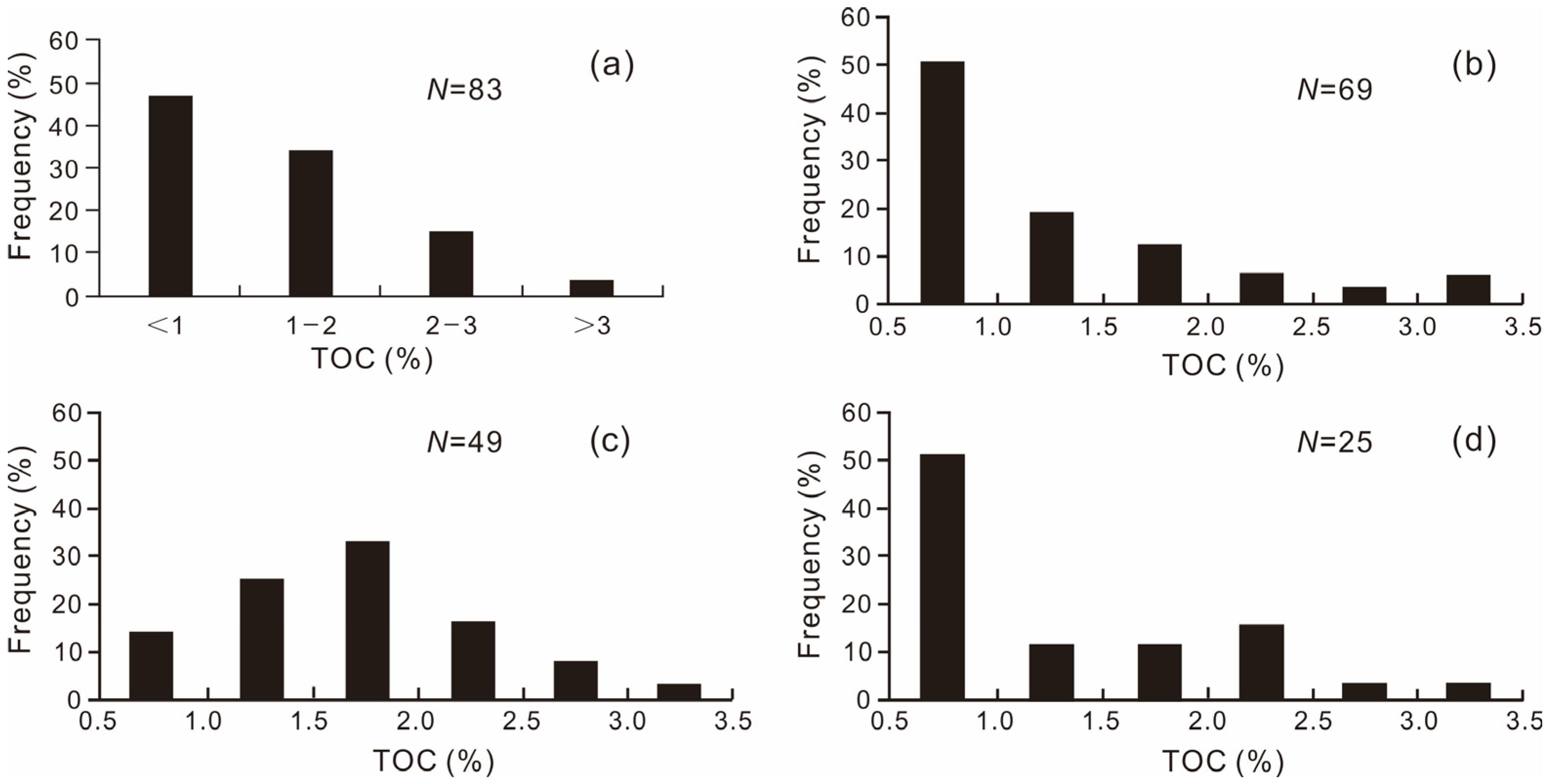
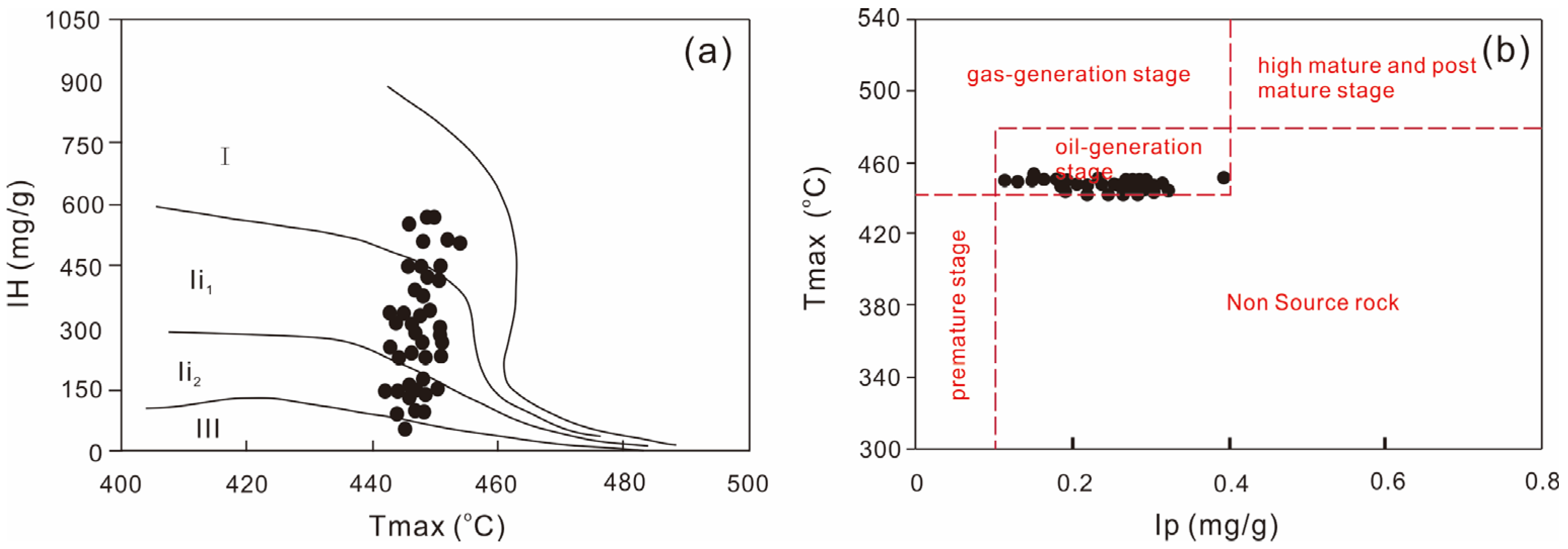
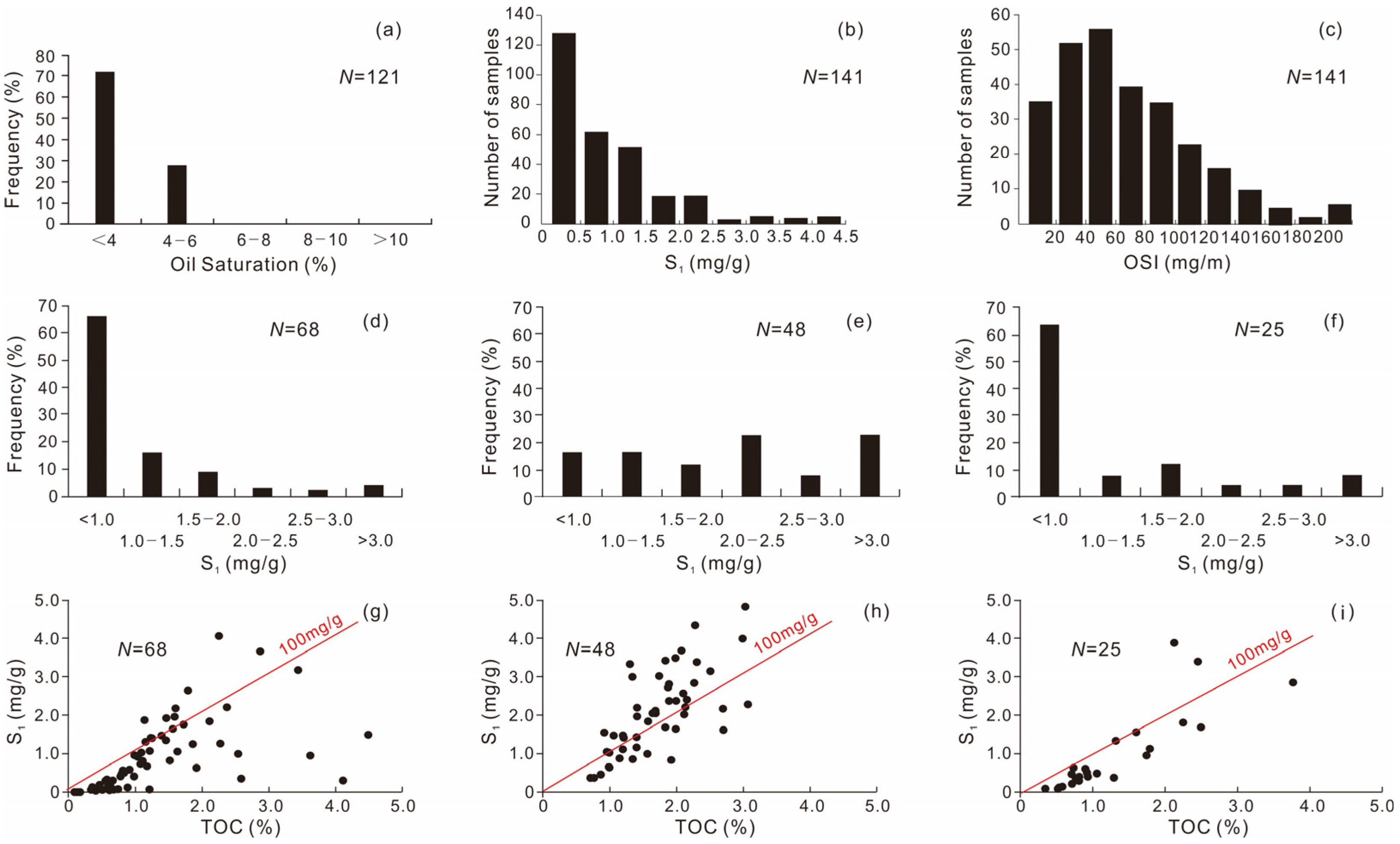
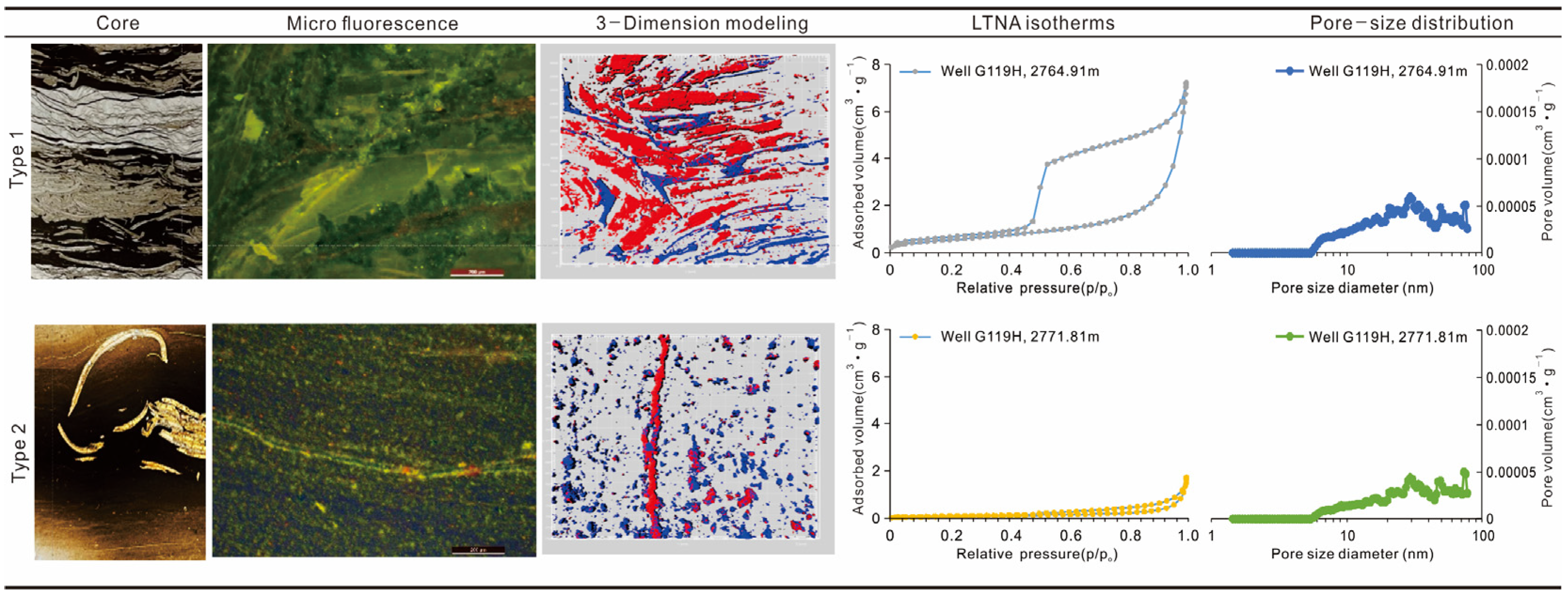



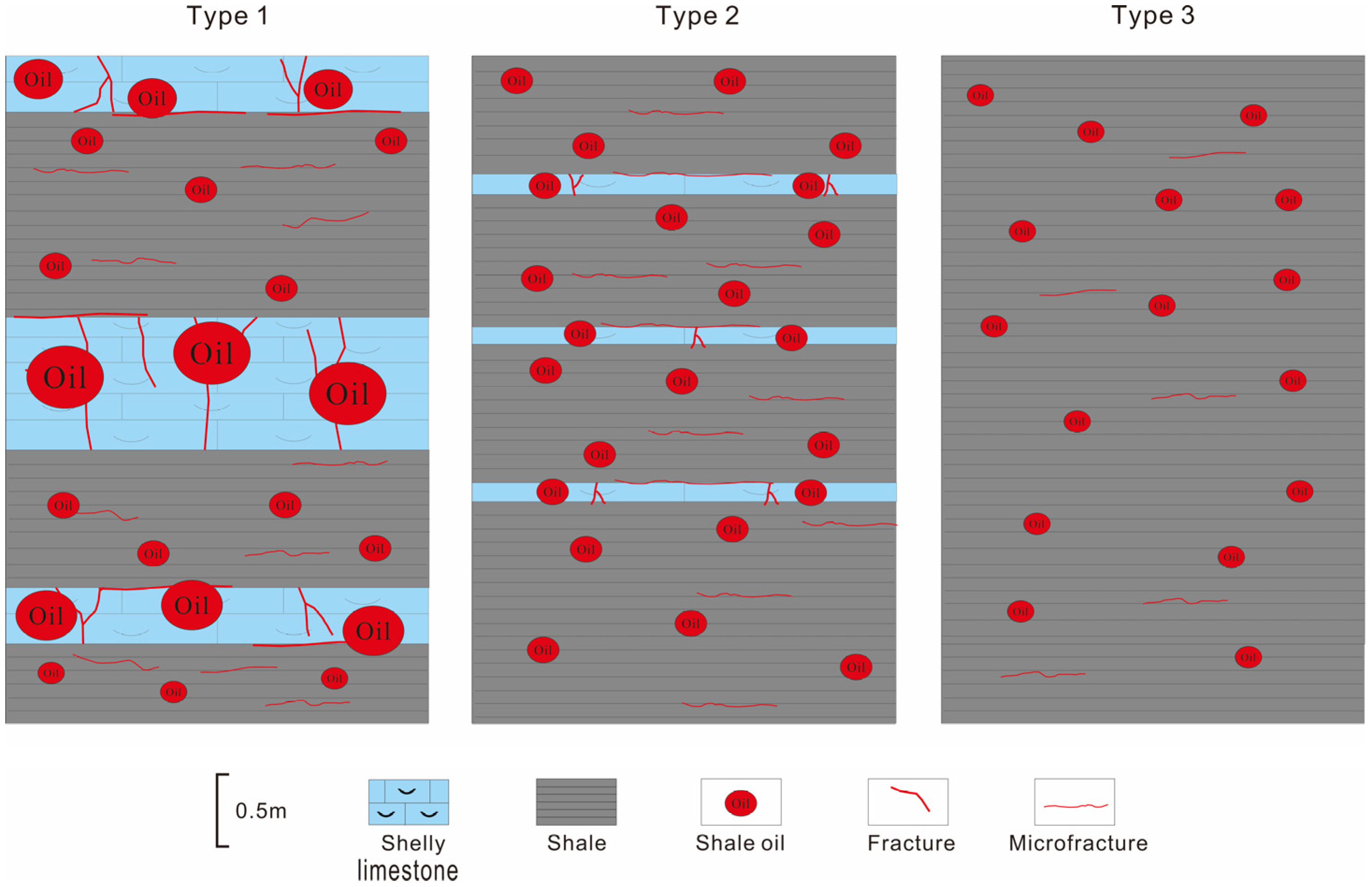

Disclaimer/Publisher’s Note: The statements, opinions and data contained in all publications are solely those of the individual author(s) and contributor(s) and not of MDPI and/or the editor(s). MDPI and/or the editor(s) disclaim responsibility for any injury to people or property resulting from any ideas, methods, instructions or products referred to in the content. |
© 2023 by the authors. Licensee MDPI, Basel, Switzerland. This article is an open access article distributed under the terms and conditions of the Creative Commons Attribution (CC BY) license (https://creativecommons.org/licenses/by/4.0/).
Share and Cite
Fang, R.; Jiang, Y.; Luo, Y.; Wang, Z.; Jiang, C.; Li, S.; Qi, L.; Yan, X. Hydrocarbon Geological Characteristics and Factors Controlling Hydrocarbon Accumulation of Jurassic Da’anzhai Continental Shale. Minerals 2024, 14, 11. https://doi.org/10.3390/min14010011
Fang R, Jiang Y, Luo Y, Wang Z, Jiang C, Li S, Qi L, Yan X. Hydrocarbon Geological Characteristics and Factors Controlling Hydrocarbon Accumulation of Jurassic Da’anzhai Continental Shale. Minerals. 2024; 14(1):11. https://doi.org/10.3390/min14010011
Chicago/Turabian StyleFang, Rui, Yuqiang Jiang, Yao Luo, Zhanlei Wang, Chan Jiang, Shun Li, Lin Qi, and Xueying Yan. 2024. "Hydrocarbon Geological Characteristics and Factors Controlling Hydrocarbon Accumulation of Jurassic Da’anzhai Continental Shale" Minerals 14, no. 1: 11. https://doi.org/10.3390/min14010011
APA StyleFang, R., Jiang, Y., Luo, Y., Wang, Z., Jiang, C., Li, S., Qi, L., & Yan, X. (2024). Hydrocarbon Geological Characteristics and Factors Controlling Hydrocarbon Accumulation of Jurassic Da’anzhai Continental Shale. Minerals, 14(1), 11. https://doi.org/10.3390/min14010011





